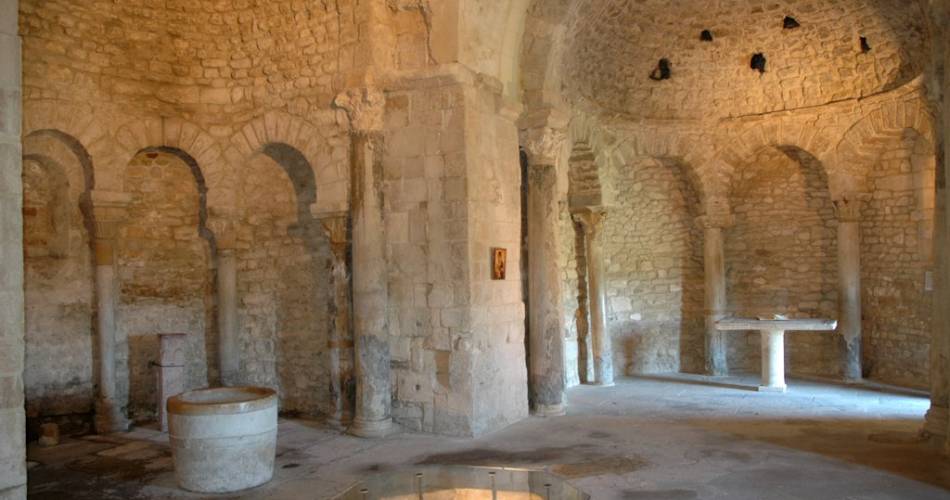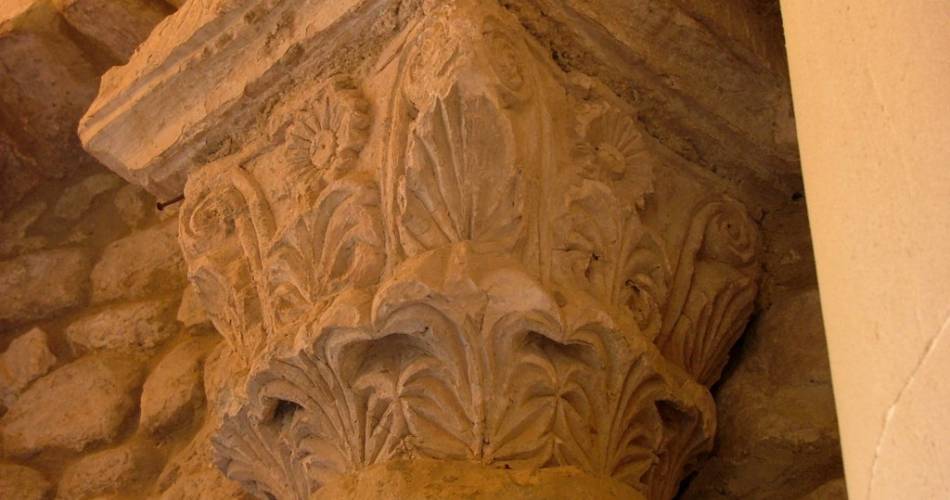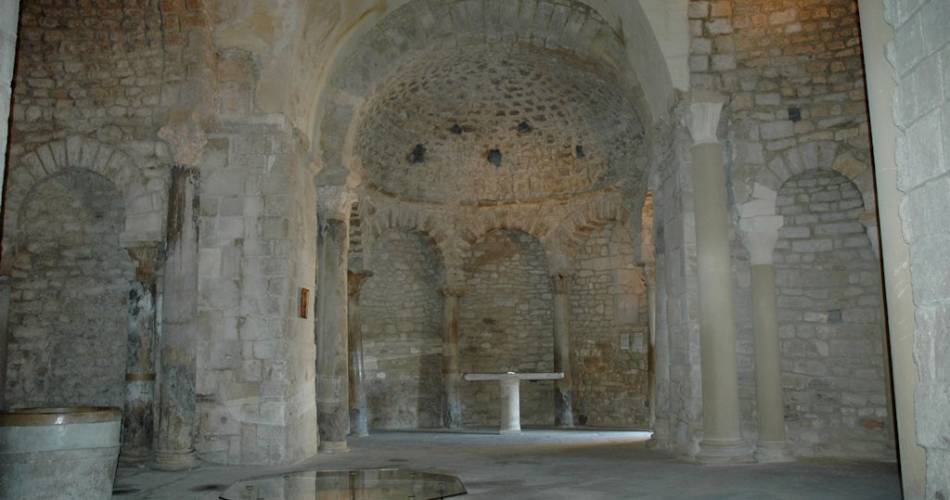Venasque
Visit to the Baptistery of Venasque
From 07/10 to 12/12/2024
Opening hours on Monday, Tuesday, Wednesday, Thursday and Friday between 10 am and 1 pm and between 2 pm and 5 pm. except on 22/10 and 23/10.
Closed Saturday and Sunday.
Event at Venasque :
The baptistery is one of the oldest Christian monuments in the region.Built at the end of the 6th century, it was remodelled in the 12th century. Visit with a leaflet.
Under the impetus of Prosper Mérimée,the MH inspector, it was restored and listed as a Historic Monument in 1840.
Fleeing the barbarian invasions, the bishops of Carpentras transferred the seat of the bishopric to the rock of Venasque between the 6th and the 10th of centuries. The base of an espiscopal group consists of a cathedral church housing the cathedra (the bishop’s seat) and a church dedicated to St John the Baptist, where the bishop baptises adults by immersion twice a year, on Easter and Pentecost eves.
At the end of the Roman Empire, Christian evangelisation in Provence became increasingly widespread. The barbarian invasions that followed forced the bishops of Carpentras to transfer the seat of the bishopric to the rock of Venasque from the 6th to the 10th century.
The base of an episcopal group consisted of a cathedral church with the cathedra (the bishop’s seat) and a church dedicated to St John the Baptist, where the bishop baptised catechumens twice a year, on the eve of Easter and Pentecost. Adults are baptised by immersion. « Baptism » comes from the Greek « baptizein », which means « to plunge, to immerse ».
The baptistery contributed to the village of Venasque’s renown.The monument was used and developed during the early Roman occupation, as evidenced by the many Roman columns, almost all of which were reused. The reuse of pagan remains for Christian worship was common between the 4th and 6th centuries.
This building, constructed at the end of the 6th century, is one of the oldest Christian monuments in the region. It was altered in the 11th, 12th ans 13th centuries, then restored in the 19th century by the Monuments Historiques under the impetus of Prosper Mérimée, and included on the first list of Monuments Historiques in 1840.
The four-lobed monument is located to the north of the church and linked to it by a vaulted corridor and opens onto a Greek cross plan. Its four apses are cross-vaulted with blind arcatures resting on reused antique columns. The capitals in the west apse date from the Merovingian period ans some are similar to those in Montmajour Abbey in the Bouches du Rhône.
On the same level as the baptistery floor, there is a small crypt church buried beneath the choir of the church datind from the 4th century, proof that a Christian community must have formed quite early on.
There are irregular holes in the vault of the north apse, the location of acoustic vases that have now disappeared.This Roman technique, borrowed from the Greeks, involved inserting fine pottery resonator vessels into the masonry to improve acoustics. This technique was used in churches right up to the Gothic period.
The history of Venasque and that of the baptistery are closely linked to the history of Provence. Each major historical period seems to have had an impact on the architectural configuration of the building.
The building was first attributed to Antiquity, then progressively to the Middle Ages by successive authors who studied its historiography.
In the 20th century, new theses motivated by the exploration of new fields highlighted 2 functions :
- 1 Baptismal function of the building
- 2 Funerary function (plan, dating of architectural elements, mortuary chapel of Bishop St Siffrein, scientific sources, cover of the tomb of Bishop Boetius,tombs).
Fleeing the barbarian invasions, the bishops of Carpentras transferred the seat of the bishopric to the rock of Venasque between the 6th and the 10th of centuries. The base of an espiscopal group consists of a cathedral church housing the cathedra (the bishop’s seat) and a church dedicated to St John the Baptist, where the bishop baptises adults by immersion twice a year, on Easter and Pentecost eves.
At the end of the Roman Empire, Christian evangelisation in Provence became increasingly widespread. The barbarian invasions that followed forced the bishops of Carpentras to transfer the seat of the bishopric to the rock of Venasque from the 6th to the 10th century.
The base of an episcopal group consisted of a cathedral church with the cathedra (the bishop’s seat) and a church dedicated to St John the Baptist, where the bishop baptised catechumens twice a year, on the eve of Easter and Pentecost. Adults are baptised by immersion. « Baptism » comes from the Greek « baptizein », which means « to plunge, to immerse ».
The baptistery contributed to the village of Venasque’s renown.The monument was used and developed during the early Roman occupation, as evidenced by the many Roman columns, almost all of which were reused. The reuse of pagan remains for Christian worship was common between the 4th and 6th centuries.
This building, constructed at the end of the 6th century, is one of the oldest Christian monuments in the region. It was altered in the 11th, 12th ans 13th centuries, then restored in the 19th century by the Monuments Historiques under the impetus of Prosper Mérimée, and included on the first list of Monuments Historiques in 1840.
The four-lobed monument is located to the north of the church and linked to it by a vaulted corridor and opens onto a Greek cross plan. Its four apses are cross-vaulted with blind arcatures resting on reused antique columns. The capitals in the west apse date from the Merovingian period ans some are similar to those in Montmajour Abbey in the Bouches du Rhône.
On the same level as the baptistery floor, there is a small crypt church buried beneath the choir of the church datind from the 4th century, proof that a Christian community must have formed quite early on.
There are irregular holes in the vault of the north apse, the location of acoustic vases that have now disappeared.This Roman technique, borrowed from the Greeks, involved inserting fine pottery resonator vessels into the masonry to improve acoustics. This technique was used in churches right up to the Gothic period.
The history of Venasque and that of the baptistery are closely linked to the history of Provence. Each major historical period seems to have had an impact on the architectural configuration of the building.
The building was first attributed to Antiquity, then progressively to the Middle Ages by successive authors who studied its historiography.
In the 20th century, new theses motivated by the exploration of new fields highlighted 2 functions :
- 1 Baptismal function of the building
- 2 Funerary function (plan, dating of architectural elements, mortuary chapel of Bishop St Siffrein, scientific sources, cover of the tomb of Bishop Boetius,tombs).
Equipments
- Car park
- Free car park
Dates and times
From 07/10 to 12/12/2024
Opening hours on Monday, Tuesday, Wednesday, Thursday and Friday between 10 am and 1 pm and between 2 pm and 5 pm. except on 22/10 and 23/10.
Closed Saturday and Sunday.
Prices
Full price: 3 €.
Free entry for children < 12 years, press, people with reduced mobility.
Spoken languages
- English
- French
Contact
Grand'Rue84210 Venasque
Phone : Show number 04 90 63 00 78
E-Mail : baptisteredevenasque@orange.fr
Website : https://reservation.ventouxprovence.fr
E-Mail : baptisteredevenasque@orange.fr
Website : https://reservation.ventouxprovence.fr
coordinates
Longitude : 5.145065Latitude : 43.997081


